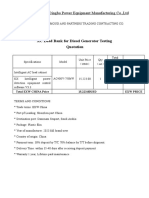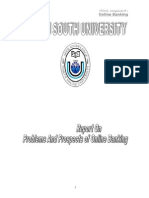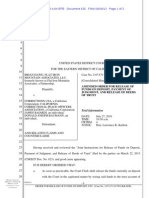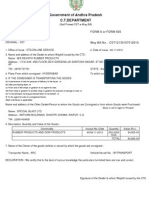0 ratings0% found this document useful (0 votes)
252 viewsOnline Banking (Or Internet Banking) Allows Customers To Conduct Financial Transactions On
Online Banking (Or Internet Banking) Allows Customers To Conduct Financial Transactions On
Uploaded by
Jamshed AlamThis document discusses online banking (also called internet banking), describing its key features and history. It notes that online banking allows customers to conduct financial transactions via a secure website operated by their bank. Common features of online banking include performing transactions like funds transfers, bill payments, and loan applications, as well as viewing account balances and statements. Additional unique features can include personal financial management tools and account aggregation. The document then provides details on the evolution and types of online banking systems in India.
Copyright:
Attribution Non-Commercial (BY-NC)
Available Formats
Download as DOCX, PDF, TXT or read online from Scribd
Online Banking (Or Internet Banking) Allows Customers To Conduct Financial Transactions On
Online Banking (Or Internet Banking) Allows Customers To Conduct Financial Transactions On
Uploaded by
Jamshed Alam0 ratings0% found this document useful (0 votes)
252 views4 pagesThis document discusses online banking (also called internet banking), describing its key features and history. It notes that online banking allows customers to conduct financial transactions via a secure website operated by their bank. Common features of online banking include performing transactions like funds transfers, bill payments, and loan applications, as well as viewing account balances and statements. Additional unique features can include personal financial management tools and account aggregation. The document then provides details on the evolution and types of online banking systems in India.
Original Title
Online banking
Copyright
© Attribution Non-Commercial (BY-NC)
Available Formats
DOCX, PDF, TXT or read online from Scribd
Share this document
Did you find this document useful?
Is this content inappropriate?
This document discusses online banking (also called internet banking), describing its key features and history. It notes that online banking allows customers to conduct financial transactions via a secure website operated by their bank. Common features of online banking include performing transactions like funds transfers, bill payments, and loan applications, as well as viewing account balances and statements. Additional unique features can include personal financial management tools and account aggregation. The document then provides details on the evolution and types of online banking systems in India.
Copyright:
Attribution Non-Commercial (BY-NC)
Available Formats
Download as DOCX, PDF, TXT or read online from Scribd
Download as docx, pdf, or txt
0 ratings0% found this document useful (0 votes)
252 views4 pagesOnline Banking (Or Internet Banking) Allows Customers To Conduct Financial Transactions On
Online Banking (Or Internet Banking) Allows Customers To Conduct Financial Transactions On
Uploaded by
Jamshed AlamThis document discusses online banking (also called internet banking), describing its key features and history. It notes that online banking allows customers to conduct financial transactions via a secure website operated by their bank. Common features of online banking include performing transactions like funds transfers, bill payments, and loan applications, as well as viewing account balances and statements. Additional unique features can include personal financial management tools and account aggregation. The document then provides details on the evolution and types of online banking systems in India.
Copyright:
Attribution Non-Commercial (BY-NC)
Available Formats
Download as DOCX, PDF, TXT or read online from Scribd
Download as docx, pdf, or txt
You are on page 1of 4
Online banking (or Internet banking) allows customers to conduct financial transactions on
a secure website operated by their retail or virtual bank, credit union or building society.
Contents
[hide]
1 Features
2 History
3 Security
4 See also
5 References
6 External links
[edit] Features
Online banking solutions have many features and capabilities in common, but traditionally
also have some that are application specific.
The common features fall broadly into several categories
Transactional (e.g., performing a financial transaction such as an account to account
transfer, paying a bill, wire transfer, apply for a loan, new account, etc.)
o Payments to third parties, including bill payments and telegraphic/wire
transfers
o Funds transfers between a customer's own transactional account and savings
accounts
o Investment purchase or sale
o Loan applications and transactions, such as repayments of enrollments
Non-transactional (e.g., online statements, cheque links, cobrowsing, chat)
o Viewing recent transactions
o Downloading bank statements, for example in PDF format
o Viewing images of paid cheques
Financial Institution Administration
Management of multiple users having varying levels of authority
Transaction approval process
Features commonly unique to Internet banking include
Personal financial management support, such as importing data into personal
accounting software. Some online banking platforms support account aggregation to
allow the customers to monitor all of their accounts in one place whether they are
with their main bank or with other institutions.
Internet banking (or E-banking) means any user with a personal computer and a browser can get connected to
his bank -s website to perform any of the virtual banking functions. In internet banking system the bank has a
centralized database that is web-enabled. All the services that the bank has permitted on the internet are
displayed in menu. Any service can be selected and further interaction is dictated by the nature of service. The
traditional branch model of bank is now giving place to an alternative delivery channels with ATM network.
Once the branch offices of bank are interconnected through terrestrial or satellite links, there would be no
physical identity for any branch. It would a borderless entity permitting anytime, anywhere and anyhow
banking.
The network which connects the various locations and gives connectivity to the central office within the
organization is called intranet. These networks are limited to organizations for which they are set up. SWIFT is
a live example of intranet application.
Internet banking in india
The Reserve Bank of India constituted a working group on Internet Banking. The group divided the internet
banking products in India into 3 types based on the levels of access granted. They are:
i) Information Only System: General purpose information like interest rates, branch location, bank products
and their features, loan and deposit calculations are provided in the banks website. There exist facilities for
downloading various types of application forms. The communication is normally done through e-mail. There is
no interaction between the customer and bank's application system. No identification of the customer is done.
In this system, there is no possibility of any unauthorized person getting into production systems of the bank
through internet.
ii) Electronic Information Transfer System: The system provides customer- specific information in the form of
account balances, transaction details, and statement of accounts. The information is still largely of the 'read
only' format. Identification and authentication of the customer is through password. The information is
fetched from the bank's application system either in batch mode or off-line. The application systems cannot
directly access through the internet.
iii) Fully Electronic Transactional System: This system allows bi-directional capabilities. Transactions can be
submitted by the customer for online update. This system requires high degree of security and control. In this
environment, web server and application systems are linked over secure infrastructure. It comprises
technology covering computerization, networking and security, inter-bank payment gateway and legal
infrastructure.
Automated Teller Machine (ATM):
ATM is designed to perform the most important function of bank. It is operated by plastic card with its special
features. The plastic card is replacing cheque, personal attendance of the customer, banking hours restrictions
and paper based verification. There are debit cards. ATMs used as spring board for Electronic Fund Transfer.
ATM itself can provide information about customers account and also receive instructions from customers -
ATM cardholders. An ATM is an Electronic Fund Transfer terminal capable of handling cash deposits, transfer
between accounts, balance enquiries, cash withdrawals and pay bills. It may be on-line or 0ff-line. The on-line
ATN enables the customer to avail banking facilities from anywhere. In off-line the facilities are confined to
that particular ATM assigned. Any customer possessing ATM card issued by the Shared Payment Network
System can go to any ATM linked to Shared Payment Networks and perform his transactions.
Credit Cards/Debit Cards:
The Credit Card holder is empowered to spend wherever and whenever he wants with his Credit Card within
the limits fixed by his bank. Credit Card is a post paid card. Debit Card, on the other hand, is a prepaid card
with some stored value. Every time a person uses this card, the Internet Banking house gets money transferred
to its account from the bank of the buyer. The buyers account is debited with the exact amount of purchases.
An individual has to open an account with the issuing bank which gives debit card with a Personal
Identification Number (PIN). When he makes a purchase, he enters his PIN on shops PIN pad. When the card is
slurped through the electronic terminal, it dials the acquiring bank system - either Master Card or VISA that
validates the PIN and finds out from the issuing bank whether to accept or decline the transactions. The
customer can never overspend because the system rejects any transaction which exceeds the balance in his
account. The bank never faces a default because the amount spent is debited immediately from the customers
account.
Smart Card:
Banks are adding chips to their current magnetic stripe cards to enhance security and offer new service, called
Smart Cards. Smart Cards allow thousands of times of information storable on magnetic stripe cards.
In addition, these cards are highly secure, more reliable and perform multiple functions. They hold a large
amount of personal information, from medical and health history to personal banking and personal
preferences.
You can avail the following services through E-Banking.
Bill payment service
You can facilitate payment of electricity and telephone bills, mobile phone, credit card and insurance
premium bills as each bank has tie-ups with various utility companies, service providers and
insurance companies, across the country. To pay your bills, all you need to do is complete a simple
one-time registration for each biller. You can also set up standing instructions online to pay your
recurring bills, automatically. Generally, the bank does not charge customers for online bill payment.
Fund transfer
You can transfer any amount from one account to another of the same or any another bank.
Customers can send money anywhere in India. Once you login to your account, you need to mention
the payees's account number, his bank and the branch. The transfer will take place in a day or so,
whereas in a traditional method, it takes about three working days. ICICI Bank says that online bill
payment service and fund transfer facility have been their most popular online services.
Credit card customers
With Internet banking, customers can not only pay their credit card bills online but also get a loan on
their cards. If you lose your credit card, you can report lost card online.
Railway pass
This is something that would interest all the aam janta. Indian Railways has tied up with ICICI bank
and you can now make your railway pass for local trains online. The pass will be delivered to you at
your doorstep. But the facility is limited to Mumbai, Thane, Nashik, Surat and Pune.
Investing through Internet banking
You can now open an FD online through funds transfer.Now investors with interlinked demat account
and bank account can easily trade in the stock market and the amount will be automatically debited
from their respective bank accounts and the shares will be credited in their demat account. Moreover,
some banks even give you the facility to purchase mutual funds directly from the online banking
system.
Nowadays, most leading banks offer both online banking and demat account. However if you have
your demat account with independent share brokers, then you need to sign a special form, which will
link your two accounts.
Recharging your prepaid phone
Now just top-up your prepaid mobile cards by logging in to Internet banking. By just selecting your
operator's name, entering your mobile number and the amount for recharge, your phone is again back
in action within few minutes.
Shopping
With a range of all kind of products, you can shop online and the payment is also made conveniently
through your account. You can also buy railway and air tickets through Internet banking.
Advantage of Internet banking
As per the Internet and Mobile Association of India's report on online banking 2006, "There are many
advantages of online banking. It is convenient, it isn't bound by operational timings, there are no
geographical barriers and the services can be offered at a miniscule cost."
Through Internet banking, you can check your transactions at any time of the day, and as many
times as you want to. Where in a traditional method, you get quarterly statements from the bank. If
the fund transfer has to be made outstation, where the bank does not have a branch, the bank would
demand outstation charges. Whereas with the help of online banking, it will be absolutely free for you.
Security Precautions
Customers should never share personal information like PIN numbers, passwords etc with anyone,
including employees of the bank. It is important that documents that contain confidential information
are safeguarded. PIN or password mailers should not be stored, the PIN and/or passwords should be
changed immediately and memorised before destroying the mailers.
Customers are advised not to provide sensitive account-related information over unsecured e-mails
or over the phone. Take simple precautions like changing the ATM PIN and online login and
transaction passwords on a regular basis. Also ensure that the logged in session is properly signed
out.
You might also like
- Bitcoin Investment FormatDocument1 pageBitcoin Investment FormatWilliams JeffreyNo ratings yet
- Fundamentals of Advanced Accounting 8th Edition Hoyle Test Bank 1Document60 pagesFundamentals of Advanced Accounting 8th Edition Hoyle Test Bank 1audra100% (59)
- ABES Engineering College: Fee ReceiptDocument1 pageABES Engineering College: Fee ReceiptSushant Tyagi100% (1)
- Question 1Document15 pagesQuestion 1Cale HenituseNo ratings yet
- AC3103 Seminar 19: Biosensors International Group (BIG) Valuation and Impairment Testing of IntangiblesDocument39 pagesAC3103 Seminar 19: Biosensors International Group (BIG) Valuation and Impairment Testing of IntangiblesTanisha GuptaNo ratings yet
- Online BankingDocument19 pagesOnline BankingJesmin Islam Juthi50% (2)
- Online BankingDocument28 pagesOnline BankingMuneeb SohailNo ratings yet
- Online BankingDocument38 pagesOnline BankingROSHNI AZAMNo ratings yet
- Bank CreditsDocument11 pagesBank CreditsAlexander DeckerNo ratings yet
- Online BankingDocument116 pagesOnline BankingVictoria Doureen NamubiruNo ratings yet
- Online BankingDocument16 pagesOnline BankingParul Tyagi0% (1)
- Online Banking - 1475002569159Document16 pagesOnline Banking - 1475002569159Zoya KhanNo ratings yet
- Load Bank Quotation-Dingbo PowerDocument1 pageLoad Bank Quotation-Dingbo PowerMahmoud Abd ElhamidNo ratings yet
- Online BankingDocument13 pagesOnline BankingHarmanSinghNo ratings yet
- Freezing of Bank Accounts by Investigating AuthoritiesDocument5 pagesFreezing of Bank Accounts by Investigating Authoritiessao hunyeNo ratings yet
- House Bill 5417Document12 pagesHouse Bill 5417Anton MercadoNo ratings yet
- Requested Format For Phone Number 1Document17 pagesRequested Format For Phone Number 1Neng SumiyatiNo ratings yet
- Online BankingDocument98 pagesOnline Bankingnitish_j100% (2)
- EXHIBIT 1 - HBMA Model Billing ContractDocument18 pagesEXHIBIT 1 - HBMA Model Billing Contractjhanine davidNo ratings yet
- Online Banking - FIN464Document58 pagesOnline Banking - FIN464Pavel093No ratings yet
- A Project Report On: E-BankingDocument25 pagesA Project Report On: E-Bankinganami11No ratings yet
- Bank Form IbDocument4 pagesBank Form IbRocky singhNo ratings yet
- Bank Management SystemDocument35 pagesBank Management SystemDhwanil P ShahNo ratings yet
- Apple Card Customer AgreementDocument19 pagesApple Card Customer AgreementMarian PahNo ratings yet
- Online Banking (Project)Document26 pagesOnline Banking (Project)Epsita PaulNo ratings yet
- Defination of Clearing HouseDocument6 pagesDefination of Clearing HouseTapashKarNo ratings yet
- Online Banking SoftwareDocument16 pagesOnline Banking SoftwareBeverly WoodNo ratings yet
- Da Afghanistan Bank Afghanistan Payments System: "The National E-Payment Switch of Afghanistan"Document34 pagesDa Afghanistan Bank Afghanistan Payments System: "The National E-Payment Switch of Afghanistan"Asef KhademiNo ratings yet
- Ebilling SDKDocument414 pagesEbilling SDKWilfred MbithiNo ratings yet
- New Client Agreement-Eff 12-6-21Document6 pagesNew Client Agreement-Eff 12-6-21Michele Ricupero VerleyNo ratings yet
- Women in CryptoDocument26 pagesWomen in CryptoRodrix Digital100% (1)
- Jiofiber Postpaid Bill FormatDocument10 pagesJiofiber Postpaid Bill Formatsystemwindows6432No ratings yet
- International Money Transfer Terms and ConditionsDocument10 pagesInternational Money Transfer Terms and ConditionssilasmafungaNo ratings yet
- Narrative of Illicit Money Yahoo Boy Format of Cyber Scams and Governance Challenges in AfricaDocument10 pagesNarrative of Illicit Money Yahoo Boy Format of Cyber Scams and Governance Challenges in Africachristiana joeNo ratings yet
- A General View On The E-BankingDocument4 pagesA General View On The E-BankingAbhishek SinghNo ratings yet
- Comcast Email LoginDocument2 pagesComcast Email LoginemailloginNo ratings yet
- Internet Banking WebsiteDocument25 pagesInternet Banking WebsiteSuresh Naveen RamuNo ratings yet
- Sajeev Padmanabhan : Sindhu Vilasam (H), Madakkathanam Post, Madakkathanam Ernakulam (Dist) 686 670, KERALA - INDIADocument6 pagesSajeev Padmanabhan : Sindhu Vilasam (H), Madakkathanam Post, Madakkathanam Ernakulam (Dist) 686 670, KERALA - INDIASajeev PadmanabhanNo ratings yet
- Oracle Revenue Management and Billing Banking User GuideDocument806 pagesOracle Revenue Management and Billing Banking User GuidesaheemmirNo ratings yet
- LogDocument1 pageLogMoises BreivaNo ratings yet
- ITunes $50 Gift CardDocument1 pageITunes $50 Gift Cardgracedennis405No ratings yet
- Faq of Banking WebsiteDocument74 pagesFaq of Banking Websitemoney coxNo ratings yet
- Agel Visa Debit Card Loading InstructionsDocument7 pagesAgel Visa Debit Card Loading InstructionsstefanoagelNo ratings yet
- How To Attract Clients and Leads On TwitterDocument6 pagesHow To Attract Clients and Leads On TwitterDaniel GedotiNo ratings yet
- Amended Order For Release of Funds On Deposit, Payment of Judgment, and Release of Deeds of TrustDocument2 pagesAmended Order For Release of Funds On Deposit, Payment of Judgment, and Release of Deeds of Trustjon_ortizNo ratings yet
- Online Banking Security Issues & ChallengesDocument10 pagesOnline Banking Security Issues & ChallengesAyunni Azalin0% (1)
- Id FormatDocument44 pagesId Formatsoftsen10100% (1)
- Carrier Billing (DOB)Document34 pagesCarrier Billing (DOB)Mahmoud Abu-GhaliNo ratings yet
- HDFC Online BankingDocument231 pagesHDFC Online BankingSumit Kumar Jaiswal100% (1)
- Format For Bank Guarantee Generator BPTADocument4 pagesFormat For Bank Guarantee Generator BPTATAHIR HUSAINNo ratings yet
- Online Banking SystemDocument21 pagesOnline Banking SystemReethuNo ratings yet
- Types of CardsDocument12 pagesTypes of CardsrodrigoelbarbaroNo ratings yet
- How To Load Amore Prepaid Card - Google SearchDocument1 pageHow To Load Amore Prepaid Card - Google SearchDanny MontanaNo ratings yet
- Interbank Mobile Payment ServiceDocument24 pagesInterbank Mobile Payment ServiceThilaga Senthilmurugan100% (1)
- State Bank CollectDocument1 pageState Bank CollecttanujNo ratings yet
- Success Story of DubaiDocument30 pagesSuccess Story of DubaiShakil SiddiquiNo ratings yet
- Bank of America Online Banking: A Critical EvaluationDocument78 pagesBank of America Online Banking: A Critical EvaluationbstefansNo ratings yet
- Government of Andhra Pradesh C.T.Department: Form of Way Bill Form X or Form 600Document3 pagesGovernment of Andhra Pradesh C.T.Department: Form of Way Bill Form X or Form 600Arjun B Menon100% (1)
- What Is Bitcoin (The Summary) 2Document3 pagesWhat Is Bitcoin (The Summary) 2jackNo ratings yet
- Smart Billing.....Document110 pagesSmart Billing.....langraNo ratings yet
- How To Send EmailDocument5 pagesHow To Send Emailcmohan1980No ratings yet
- Banking FruadsDocument43 pagesBanking FruadsMohd AquibNo ratings yet
- Truck, Utility Trailer & RV Rental & Leasing Revenues World Summary: Market Values & Financials by CountryFrom EverandTruck, Utility Trailer & RV Rental & Leasing Revenues World Summary: Market Values & Financials by CountryNo ratings yet
- E ListedCompaniesDocument5 pagesE ListedCompaniesfarougfaridNo ratings yet
- This Study Resource Was: (Jefferson Corporation)Document8 pagesThis Study Resource Was: (Jefferson Corporation)Illion IllionNo ratings yet
- Demo Nism 10a Invt Advisor Level 1 Module PDFDocument7 pagesDemo Nism 10a Invt Advisor Level 1 Module PDFsantucan10% (1)
- Metrobank Branch Application Form Ao Feb 2023Document2 pagesMetrobank Branch Application Form Ao Feb 2023shanelynmg100% (1)
- Account BookDocument311 pagesAccount BookRam patharvat100% (1)
- Assignment No. 1 - Leases - Cunanan & ManlangitDocument7 pagesAssignment No. 1 - Leases - Cunanan & ManlangitCunanan, Malakhai JeuNo ratings yet
- International Cheque ApplicationDocument2 pagesInternational Cheque ApplicationsureNo ratings yet
- Thanh Toan Dien TuDocument348 pagesThanh Toan Dien TuPhương Trần Thị AnhNo ratings yet
- How To Calculate Present ValuesDocument16 pagesHow To Calculate Present ValuesAishwarya PotdarNo ratings yet
- The Intelligent InvestorDocument69 pagesThe Intelligent InvestorRaheel SulemanNo ratings yet
- PT. Manis Logistik Buku Besar Periode 1 Juli 2023 S/D 31 Juli 2023 Nomor Nama AkunDocument8 pagesPT. Manis Logistik Buku Besar Periode 1 Juli 2023 S/D 31 Juli 2023 Nomor Nama AkunJamil AvishaNo ratings yet
- Introduction To Financial Systems and Financial MarketDocument11 pagesIntroduction To Financial Systems and Financial MarketAuie Eugene Frae SalameraNo ratings yet
- ECGCDocument22 pagesECGCabhi7oct1987No ratings yet
- L2 Statement of Financial Position For Sole TraderDocument1 pageL2 Statement of Financial Position For Sole TraderMyo AccountancyNo ratings yet
- Risk ManagementDocument6 pagesRisk Managementsudarshan1985No ratings yet
- Textual Learning Material - Module 2Document34 pagesTextual Learning Material - Module 2Jerry JohnNo ratings yet
- Clearing Code and Branch Code (23 Oct 2020) With Tel NoDocument343 pagesClearing Code and Branch Code (23 Oct 2020) With Tel NoAV Team3No ratings yet
- Savings Bank Accounts Rules & RegulationsDocument3 pagesSavings Bank Accounts Rules & Regulationsmanish sharmaNo ratings yet
- Martinez V RamosDocument1 pageMartinez V RamosattyalanNo ratings yet
- Guidelines For Standard Products For Fire and Allied Perils - Bharat Griha Raksha, Bharat Sookshma Udyam Suraksha and Bharat Laghu Udyam SurakshaDocument17 pagesGuidelines For Standard Products For Fire and Allied Perils - Bharat Griha Raksha, Bharat Sookshma Udyam Suraksha and Bharat Laghu Udyam SurakshaAtul KumarNo ratings yet
- Presentation1 ReshmaDocument26 pagesPresentation1 ReshmaJOE NOBLE 2020519No ratings yet
- Lalakay Elementary School: Statement of AccountDocument4 pagesLalakay Elementary School: Statement of AccountReyes C. ErvinNo ratings yet
- PUP - Financial Management - Post Midterm Exam AsynchronousDocument33 pagesPUP - Financial Management - Post Midterm Exam AsynchronousJan Allyson BiagNo ratings yet
- Audit ReveiwerDocument25 pagesAudit ReveiwerWinny PoeNo ratings yet
- Aspire CR - Conso Question - Bank - Nov 21Document12 pagesAspire CR - Conso Question - Bank - Nov 21Richie BoomaNo ratings yet
- Customer Accounts - UnlockedDocument183 pagesCustomer Accounts - UnlockedMac SharmaNo ratings yet

























































































